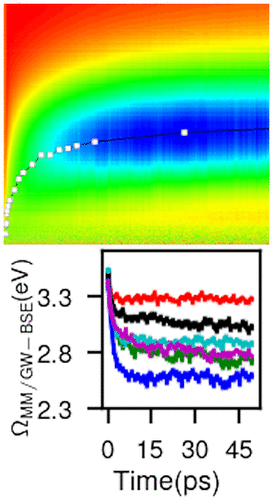当前位置:
X-MOL 学术
›
J. Phys. Chem. B
›
论文详情
Our official English website, www.x-mol.net, welcomes your feedback! (Note: you will need to create a separate account there.)
Ultrafast Formation of the Charge Transfer State of Prodan Reveals Unique Aspects of the Chromophore Environment.
The Journal of Physical Chemistry B ( IF 3.3 ) Pub Date : 2020-03-24 , DOI: 10.1021/acs.jpcb.0c00121 Swapnil Baral 1 , Matthew Phillips 2 , Han Yan 2 , Joseph Avenso 1 , Lars Gundlach 1, 2 , Björn Baumeier 3, 4 , Edward Lyman 1, 2
The Journal of Physical Chemistry B ( IF 3.3 ) Pub Date : 2020-03-24 , DOI: 10.1021/acs.jpcb.0c00121 Swapnil Baral 1 , Matthew Phillips 2 , Han Yan 2 , Joseph Avenso 1 , Lars Gundlach 1, 2 , Björn Baumeier 3, 4 , Edward Lyman 1, 2
Affiliation

|
Lipophilic dyes such as laurdan and prodan are widely used in membrane biology due to a strong bathochromic shift in emission that reports the structural parameters of the membrane such as area per molecule. Disentangling of the factors which control the spectral shift is complicated by the stabilization of a charge-transfer-like excitation of the dye in polar environments. Predicting the emission therefore requires modeling both the relaxation of the environment and the corresponding evolution of the excited state. Here, an approach is presented in which (i) the local environment is sampled by a classical molecular dynamics (MD) simulation of the dye and solvent, (ii) the electronically excited state of prodan upon light absorption is predicted by numerical quantum mechanics (QM), (iii) the iterative relaxation of the environment around the excited dye by MD coupled with the evolution of the excited state is performed, and (iv) the emission properties are predicted by QM. The QM steps are computed using the many-body Green’s function in the GW approximation and the Bethe–Salpeter equation with the environment modeled as fixed point charges, sampled in the MD simulation steps. The comparison to ultrafast time-resolved transient absorption measurements demonstrates that the iterative molecular mechanics (MM)/QM approach agrees quantitatively with both the polarity-dependent shift in emission and the time scale over which the charge transfer state is stabilized. Together the simulations and experimental measurements suggest that the evolution into the charge transfer state is slower in amphiphilic solvents.
中文翻译:

Prodan 电荷转移态的超快形成揭示了发色团环境的独特方面。
诸如 laurdan 和 prodan 等亲脂性染料因其发射时强烈的红移而被广泛应用于膜生物学中,从而报告膜的结构参数(例如每个分子的面积)。由于极性环境中染料的电荷转移样激发的稳定性,控制光谱偏移的因素的解开变得复杂。因此,预测发射需要对环境的弛豫和激发态的相应演化进行建模。这里提出了一种方法,其中(i)通过染料和溶剂的经典分子动力学(MD)模拟对局部环境进行采样,(ii)通过数值量子力学预测光吸收时普罗丹的电子激发态( QM),(iii) 通过 MD 结合激发态的演化对激发染料周围的环境进行迭代弛豫,以及 (iv) 通过 QM 预测发射特性。QM 步骤是使用GW近似中的多体格林函数和 Bethe-Salpeter 方程计算的,其中环境建模为定点电荷,在 MD 模拟步骤中采样。与超快时间分辨瞬态吸收测量的比较表明,迭代分子力学 (MM)/QM 方法在数量上与极性相关的发射偏移和电荷转移状态稳定的时间尺度一致。模拟和实验测量表明,在两亲性溶剂中,电荷转移状态的演化速度较慢。
更新日期:2020-03-24
中文翻译:

Prodan 电荷转移态的超快形成揭示了发色团环境的独特方面。
诸如 laurdan 和 prodan 等亲脂性染料因其发射时强烈的红移而被广泛应用于膜生物学中,从而报告膜的结构参数(例如每个分子的面积)。由于极性环境中染料的电荷转移样激发的稳定性,控制光谱偏移的因素的解开变得复杂。因此,预测发射需要对环境的弛豫和激发态的相应演化进行建模。这里提出了一种方法,其中(i)通过染料和溶剂的经典分子动力学(MD)模拟对局部环境进行采样,(ii)通过数值量子力学预测光吸收时普罗丹的电子激发态( QM),(iii) 通过 MD 结合激发态的演化对激发染料周围的环境进行迭代弛豫,以及 (iv) 通过 QM 预测发射特性。QM 步骤是使用GW近似中的多体格林函数和 Bethe-Salpeter 方程计算的,其中环境建模为定点电荷,在 MD 模拟步骤中采样。与超快时间分辨瞬态吸收测量的比较表明,迭代分子力学 (MM)/QM 方法在数量上与极性相关的发射偏移和电荷转移状态稳定的时间尺度一致。模拟和实验测量表明,在两亲性溶剂中,电荷转移状态的演化速度较慢。



























 京公网安备 11010802027423号
京公网安备 11010802027423号